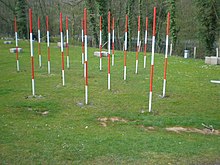Range pole

A range pole (also an escape pole or Mire or Jalon ) is a means of surveying and geodesy . It is used to signal the points, boundary points or routes to be measured .
The name comes from the alignment or alignment , where a third range pole is placed in the straight line between two bars. The staff straightener or the plumb line are used for precise vertical alignment .
The range pole is approx. 2 m long and made of red and white painted steel , pine wood or plastic . It has a round cross-section (25 mm diameter) and a steel point so that it can be rammed well into the ground or z. B. can expose overgrown boundary stones .
Thanks to the two-tone paint, the leveling poles are easily recognizable from afar. The color fields are usually 50 cm long and allow (used lying down) approximate distance measurements . You can also use 1-meter sticks, which are put together with attachments of 2 m or more. A distinction is made between white and red heads, depending on the color above. To make it easier to search through, ranging poles, which are placed in a row, are often set up with alternating heads.
If a range pole cannot be rammed into the ground on hard ground (e.g. road, survey point), it is brought to a standstill with a range pole tripod (tripod with steel legs and clamp, also known as a pole tripod or spider).
The position of a boundary stone to be set can be marked over a grave hole with two alignment poles lying at right angles to each other ( secured against rolling away with counting needles , touching the tips) . The point at which the boundary stone is to be set is plumbed to the bottom of the hole with a plumb line.